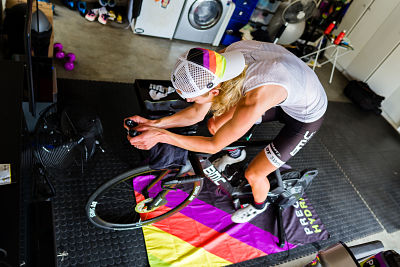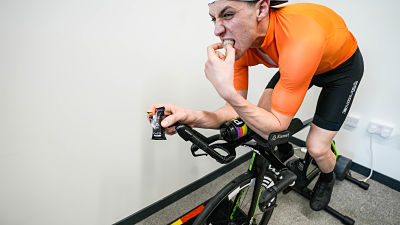History is scattered with examples of athletes who’ve sailed up to, gone over, or just plain forgotten where the ethical red lines are with competitive sport. At one end of the ethical scale, you’ve got Dick Fosbury who innovatively (and legally) sent himself backwards over the high jump bar at the 1968 Olympic Games, and at the other end of the scale there’s modern pentathlete Boris Onishchenko who decided anything goes by modifying his fencing épée to register a hit whether he’d actually touched his opponent or not in 1976.
Time and technology move on but the issues remain the same. We’ve now got the interesting scenario of 'weight-doping' in indoor cycling where the odd rider is hidden away in the depths of their garage plugged into Zwift as a svelte 5ft female when in reality they're a 6ft 4" male weighing 300 pounds. As the stakes rise, so do the temptations.
However, once you’ve had the ethical debate, it’s commonly the margins right by the rule limits where the performance gains are made, so I wanted to get you thinking about how to actively weaponise your indoor cycling – legally and without fear of disappearing into a Gulag in Siberia.
Here are five areas of your indoor set up for you to consider optimising...
Cooling systems
Riding indoors generates a lot of excess heat. This can inhibit your performance as your body then has to protect itself by keeping cool through sweating to help avoid heat stroke or dehydration. And boy do we sweat… a lot. This dripping sweat can also damage your bike.
Ultimately, maintaining optimal core body temperature is important and to combat this, we often use a fan. However, you might not have optimised the direction, number, type, size and power of the fans. I would strongly suggest you play around with the speed, position and number of fans you use.
The way I teach this is not to be focused on the wrong problem (i.e. how do we simulate outdoor cycling inside?) but instead focus on the real problem (how do we create optimal cooling?). You may find firing the air flow onto your back and neck feels better than merely sticking the fan in your face. The energy crisis in the UK means I may have to get family members to wave handmade fans as a support team for my occasional epic four-hour indoor rides.

Furthermore, the clothing that’s worn by an athlete can also influence their core body temperature. Some companies sell clothing designed for indoor cycling or sell ice vests, but you can also consider cheap hacks such as sticking an ice pack or bag of peas (anything to get out of eating them) inside your vest or shorts and seeing what that does to your racing. Cooling strategies like this have been shown to help performance.
Additionally, couple that cool pack with a fan in the right direction and you’ve got a home-hacked temporary air conditioning system. Don’t worry if you look like a catwalk disaster - you gave up dignity when you chose a sport that involved copious amounts of lycra and a helmet that made you look like a 1950’s sci fi B movie alien.
Power and bike fits
All current cycling e-racing apps provide an avatar that could be considered a typical visual representation of a human being pedalling a bicycle. Now here’s the thing, the app doesn’t know or care what the rider’s actual set up is at home provided you’re riding a bike.
However, it has been shown that subtle adjustments in saddle height and position can affect the cyclist’s net power production. At which point, whilst arguably disingenuous, there’s nothing to stop the cyclist taking a wrench to their indoor bike to maximise their power production – even to the point that the bicycle would essentially be too awkward or twitchy to ride outdoors.
Since the e-racer no longer has to steer or balance the bicycle or worry about aerodynamics, your prime concern purely becomes the physical production of power. Messing around with saddle and handlebar positions is a good place to start experimenting here.
Optimised trainer selection
Much in the same way that the selection of sports equipment can affect the performance of an athlete, the selection of a particular trainer can also affect how you perform online. For example, all trainers offer some level of inertia. This is intended to simulate the same sensation of when riding in reality (such as when coasting or accelerating the bicycle). With trainers though, this is typically simulated through their use of a weighted flywheel and sometimes motors.
However, the feel and the sensations this offers to a particular rider on a particular style of virtual course may lead to some trainers being more beneficial than others. Plus, it’s also unlikely that all trainers will record power output to the same absolute level based on their factory settings.
Frankly, I know of one brand of trainer that has a tendency to read slightly favourably but with another slightly low. It’s perfectly legal for you to do some reading around and find out if any particular model of trainer provides more elevated power output readings than other trainers or a feel that you prefer and to use that for your e-racing.
Q-factor optimisation
The spacing between the pedals on a bicycle is typically dictated by the crank design and the bottom bracket width of a bicycle. The dimensional horizontal distance between the pedals is referred to as a cyclists' ‘Q-factor’.
It has been shown that the Q-factor should be optimised for each rider to then maximise their power production, but this is often dictated by the type of gearing and the norms of conventional bicycle design and manufacture.

For example, traditional exercise bicycles found in a gym often have very wide q-factors due to their unique design and that actually often eats into your efficiency. At which point, it may be advantageous for e-racers to consider their Q-factor with their set ups. A good bike fit may help here.
Avatar customisation
Now here’s one to bake your noodle. Whilst cycling within an app is inherently a physical endeavour, the ability to customise the visual appeal of an avatar in a favourable light could serve to augment your performance.
In the physical world, it has been proposed that colours can influence sporting performance and it’s well known that a person’s appearance changes our perceptions of them. For example, if you go on a group ride outdoors and someone is wearing a national champions jersey, does that change your perception of them? I suspect it does.
Furthermore, it has been shown in conventional online gaming that avatar choice and design can affect a participant’s identification and self-esteem. As a result, it’s not unreasonable to assume the same effect could also occur within indoor cycling. With that in mind, have a think about how you present yourself online. Your avatar, despite being artificial, could still intimidate and influence the behaviour of those you're racing against just based on how it appears. Think about your virtual bike, sunglasses and jersey colour and design. Hell, I would dress as Goofy, ride a penny farthing and then drop the watt bomb in every online crit I entered if I had my way.
In summary, what you might want to think about in the future is to recognise that racing a bicycle virtually is its own sport, with its own unique opportunities and then think about how you can improve your experience and performance.
